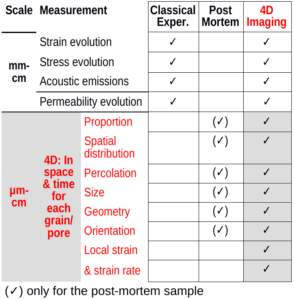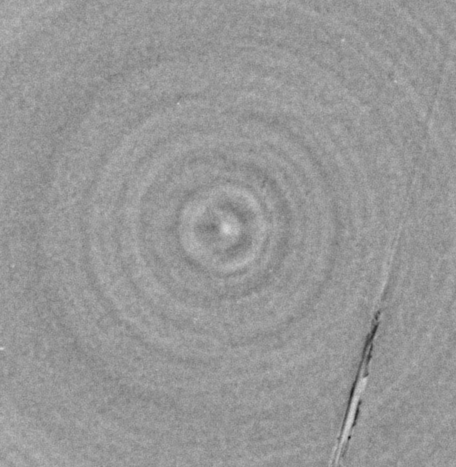- PDRAs: James Gilgannon, Damien Freitas (formerly also Roberto Rizzo)
- Co-Is: Ian Butler, Steve Elphick, Sohan Seth (all UoE), John Wheeler (U Liverpool)
- PI: Florian Fusseis
Overview
This research project uses a novel methodological approach to determine where mineral dehydration reactions can trigger failure in deforming rocks. This link between dehydration and failure is important at convergent plate boundaries. Where plates collide, the shallow portions of the Earth's crust are affected by so-called thin-skinned tectonics. There, dehydration reactions enable the emplacement of tectonic nappes, which shape mountain belts such as the Swiss Jura, or the Appalachians in the US. Plate collision also leads to the subduction of tectonic plates, where dehydration reactions are suspected to trigger seismic events at depths of several tens of kilometers. In both tectonic settings hydrous minerals in rocks become unstable as temperature increases. They start to transform into denser minerals by releasing water in dehydration reactions. The density increase produces pores, which are filled by the water. The pores, the fluid pressure in them, and the newly grown minerals weaken the reacting rock mechanically. It may become unable to support tectonic stresses and fail.
The processes that control large-scale tectonics start at the grain scale. These grain scale processes entail a series of complicated, intertwined developments that involve the chemistry, hydraulics and mechanics of a dehydrating rock. Coupled chemical, hydraulic and mechanical processes may facilitate the self-organization of the dehydrating rock into a state where it ultimately fails. Unfortunately, neither classical laboratory experiments nor field-based studies allow a spatial and temporal (4D) characterization of these coupled processes on the micro-scale. Models to explain failure in dehydrating rocks therefore lack a robust observational basis.

In this project, we use a combination of methods to overcome this severe limitation and quantify the parameters listed in the table above. We are currently building two new experimental triaxial vessels that can be heated up to 450 °C and pressurized to 100 MPa confining pressure and are transparent to x-rays. These vessels allow us to reproduce conditions at the base of tectonic nappes and at intermediate depths in subduction zones. We will employ them at different Synchrotron light sources in Europe and the US to directly observe dehydration reactions in deforming rocks using time-resolved (4D) x-ray microtomography. New analysis techniques based on deep learning will allow us to extract the relevant information from these vast quantities of data. Our analyses will determine conditions where dehydration causes rocks to become unable to support tectonic stresses. Using these analyses, we will test and advance theoretical concepts used to link dehydration and deformation in numerical simulations.

Animated GIF showing a horizontal section through a dehydrating alabaster sample (~300x300 µm) imaged using x-rays. Growth of individual hemihydrate grains (light grey) and the porous moates that form around them (black) is clearly visible. In this project, we aim to quantify this evolution of such samples completely in 4D.
The first direct quantification of the complex grain-scale developments during dehydration reactions will support the interpretation of field data that otherwise capture a static, fossilized picture of dehydration reactions. Our data will allow testing and refining existing mathematical models that provide a foundation for robust simulations of large-scale tectonic processes. Ultimately, our findings will support the assessment of risks associated with plate collision. Our project will also make a new experimental imaging method available for research on geothermal energy, CO2 sequestration and nuclear waste storage. The method combines time-resolved x-ray microtomography in our new experimental vessels with advanced data mining and image analysis and computational simulation.
Relevant publications
- Marti, S., Fusseis, F., Butler, I. B., Schlepütz, C., Marone, F., Gilgannon, J., ... & Yang, Y. (2021). Time-resolved grain-scale 3D imaging of hydrofracturing in halite layers induced by gypsum dehydration and pore fluid pressure buildup. Earth and Planetary Science Letters, 554, 116679.
- Butler, I., Fusseis, F., Cartwright-Taylor, A., & Flynn, M. (2020). Mjölnir: a miniature triaxial rock deformation apparatus for 4D synchrotron X-ray microtomography. Journal of synchrotron radiation, 27(6).
- Marone, F., Schlepütz, C.M., Marti, S., Fusseis, F., Velásquez-Parra, A., Griffa, M. … (2019). Time resolved in-situ X-ray tomographic microscopy unraveling dynamic processes in geologic systems, Frontiers in Earth Science 7, 346.
- Bedford, J., Fusseis, F., Leclere, H., Wheeler, J., Faulkner, D. (2017). A new 4D view on the evolution of metamorphic dehydration reactions. Scientific Reports 7(1), 6881, DOI: :10.1038/s41598-017-07160-5.
